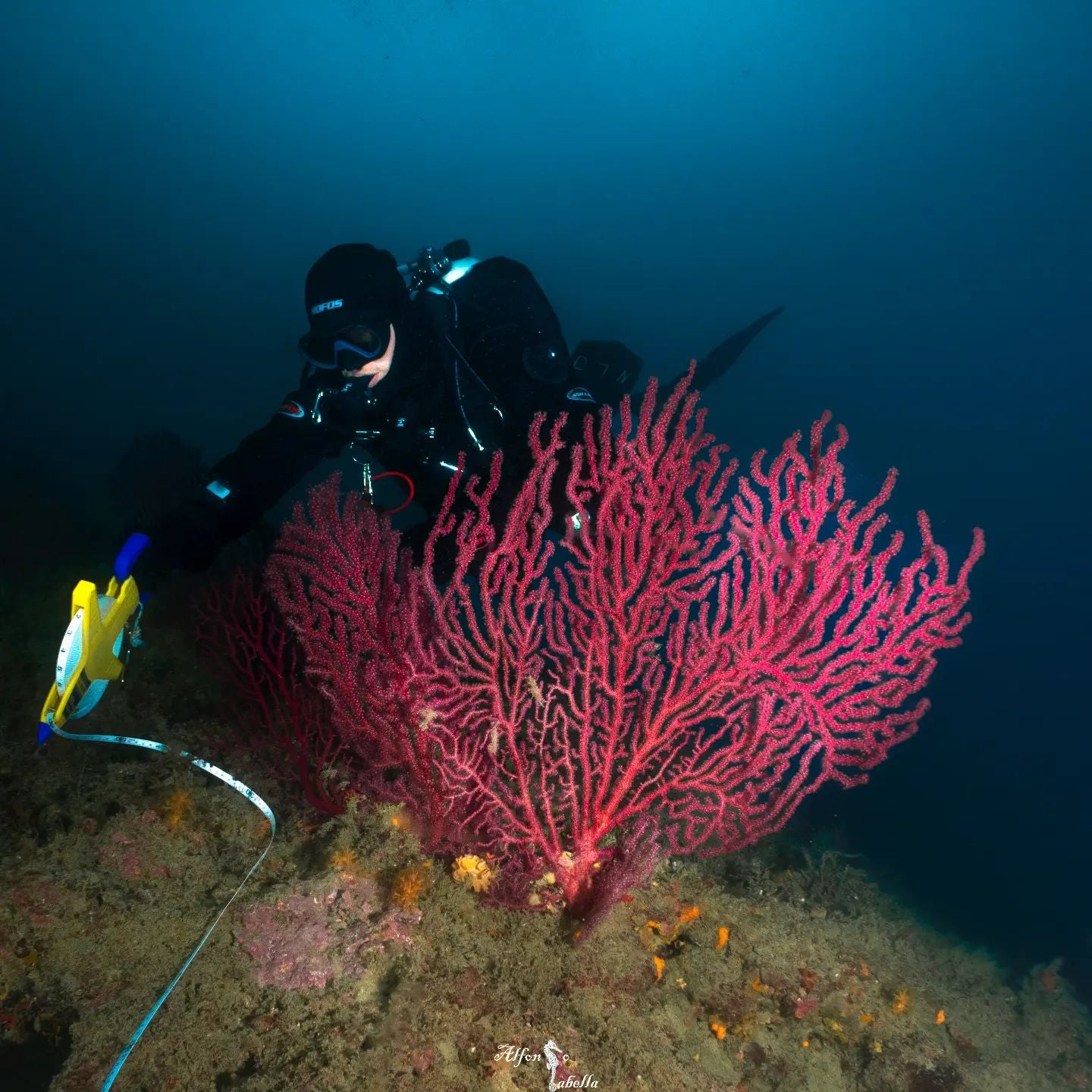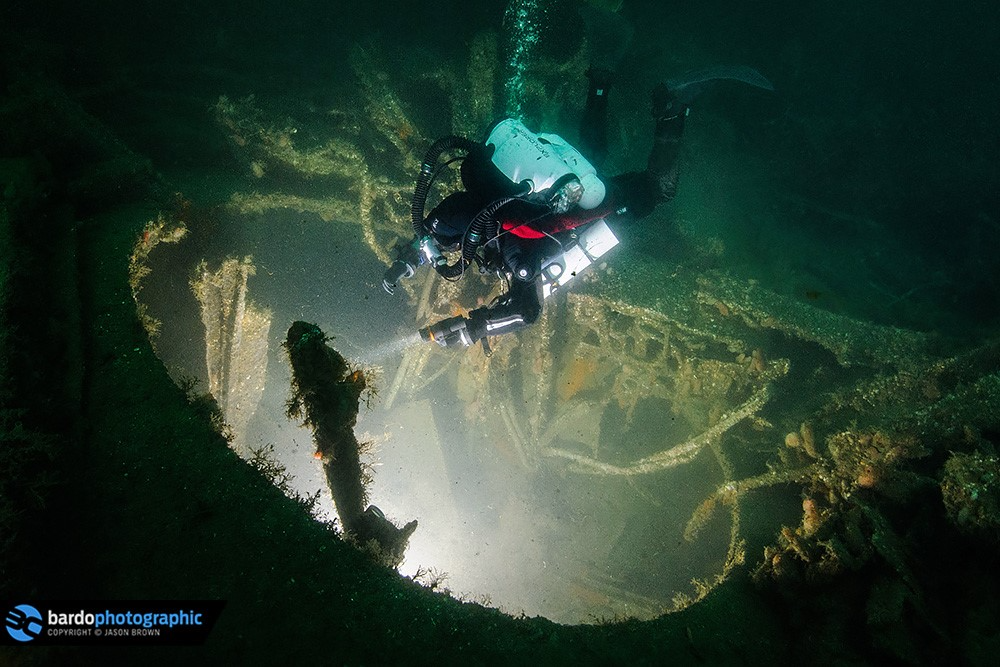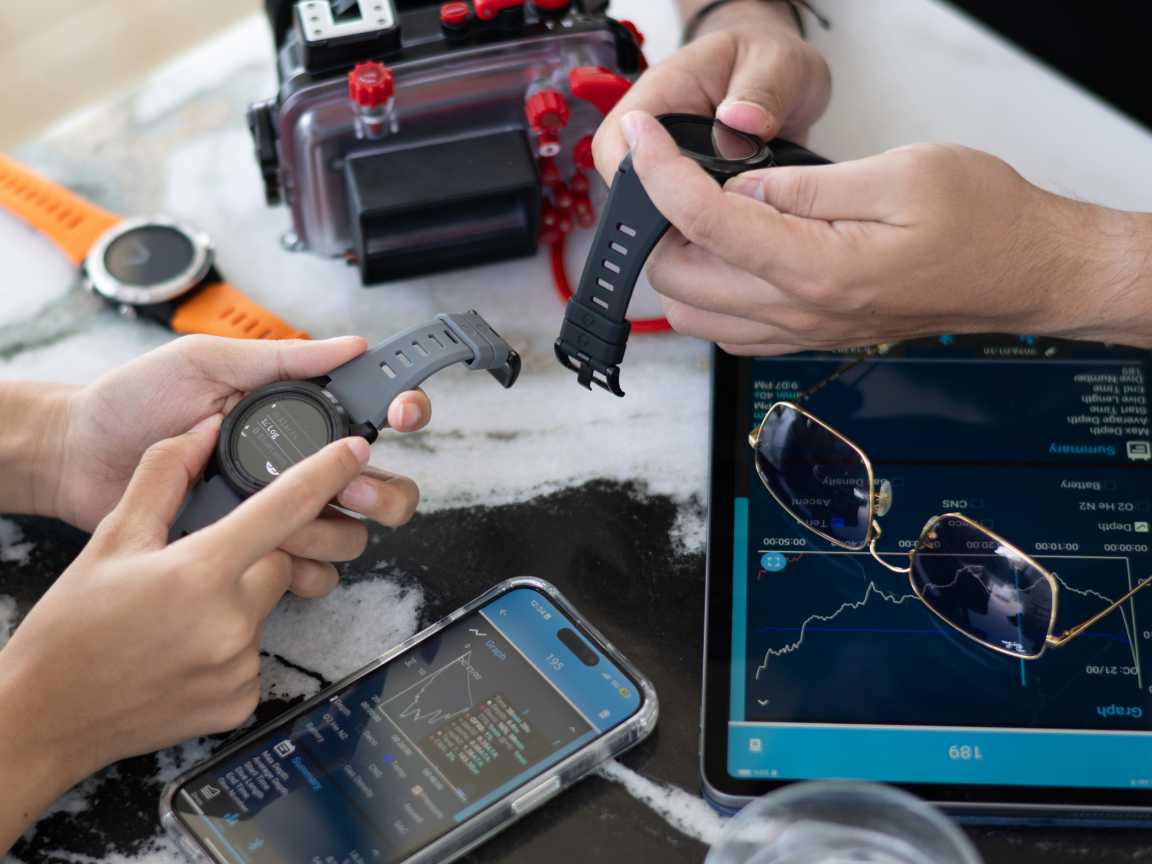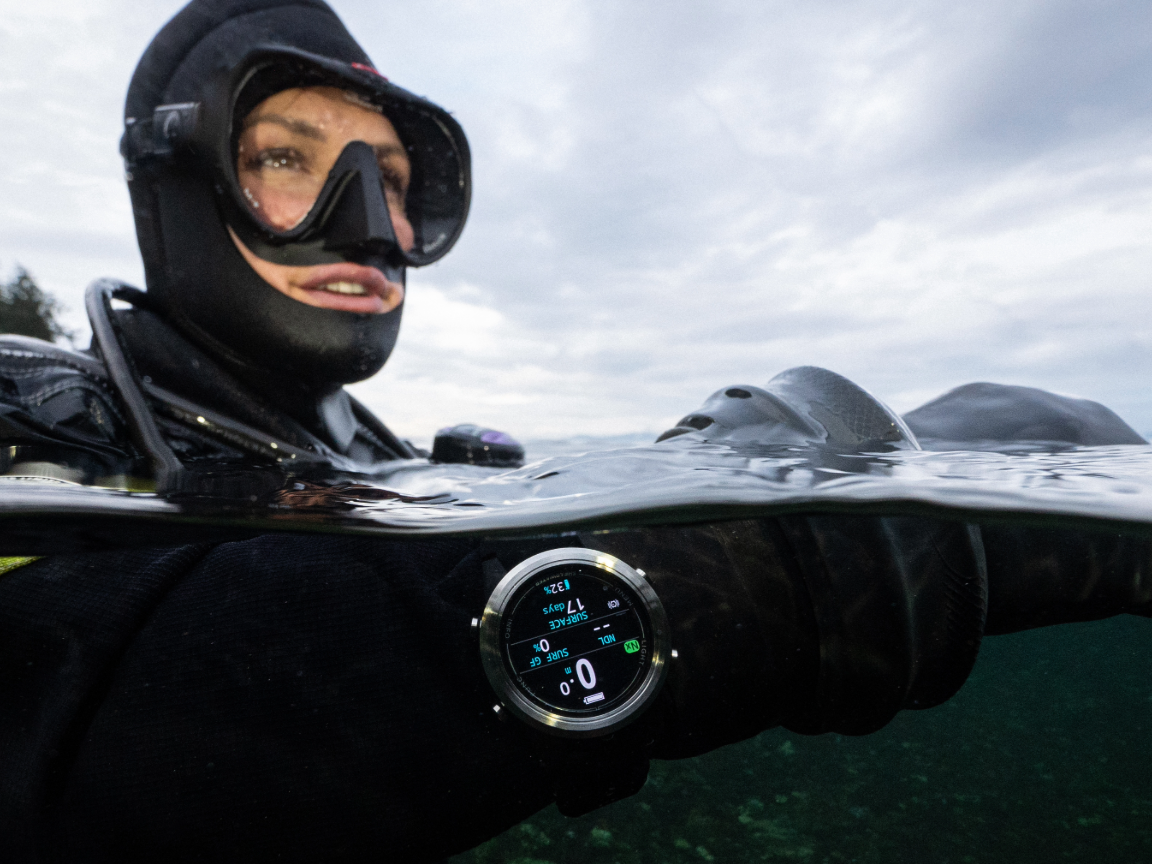Getting cooked in my dry suit and carrying so much gear that I look like a swimming Christmas tree can only mean one thing, we are going for another scientific dive!
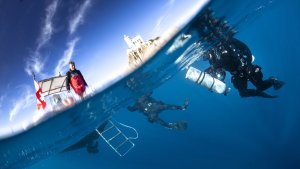
Photo courtesy of Niccolò Crespi.
For two months, my team and I collected photographic samples in the beautiful marine protected area (MPA) of Portofino, Italy. To get here, it took multiple months of honing my diving skills, writing research proposals, and planning logistics. You might ask what all of this is for. Well, let’s take a step back. My name is Nils, I am a technical scientific diver, and I recently graduated from my Master's program in marine biology. For my Master's thesis, at the Department of Life and Environmental Sciences (DiSVA) of the Marche Polytechnic University, I investigated the effects of marine animal forests on the underlying benthic community in the upper mesophotic zone. That is a lot of topics at once, so let us pick it apart.
In the scientific literature, the mesophotic zone has been most often described as the area between 40 and 120 m of depth. These limits are based on convention and do not necessarily reflect a change in biological parameters. Therefore, a more meaningful and unambiguous definition has been introduced for the Mediterranean mesophotic zone. As upper limit, the depth at which 1 % of the surface irradiance arrives, and as lower limit the deepest depth at which primary producers can be found. As a result, the mesophotic zone is placed between the light intense euphotic zone and the dark aphotic zone. Now that we have the definition out of the way, what is so important about this zone?

Photo courtesy of Niccolò Crespi.
It is no secret that coral reefs worldwide are in decline as a result of a combination of global and local stressors such as, overfishing, storm damage, sedimentation, eutrophication, toxic discharge, disease, ocean acidification, and thermal stress. These impacts are believed to be mitigated at deeper depths, not or only partially affecting mesophotic ecosystems. Furthermore, mesophotic ecosystems are less exposed to thermal anomalies and the related mass-mortality events that are occurring in the Mediterranean Sea, especially during recent decades. In theory, the mesophotic zone could serve as an important refugium for organisms escaping unfavourable conditions in the upper water layers and could replenish shallower reefs by providing a nursery ground for larvae and juveniles. These functions are highly debated and urgently require more scientific attention.

Photo courtesy of Niccolò Crespi.
Easier said than done. Due to its depth, exploring the mesophotic zone is associated with high costs, specialised equipment, as well as training and experience. Recreational divers can usually reach a maximum depth of 40 m, beyond that the realm of technical diving begins. Therefore, many studies focus on shallow water habitats only. Another option for the exploration of the mesophotic zone would be using submersibles. They can reach deep depths and carry heavy equipment like high-resolution cameras. However, due to their high operating cost, submersibles have mostly been used in deeper environments, leaving the mesophotic zone largely unexplored. The good news, for all divers and curious people out there, is that advanced scuba diving technologies, such as mixed gases (Trimix) and closed-circuit rebreathers (CCR), make observations and manipulative experiments at mesophotic depths possible. Given the unmatched capability of direct observations and sample collection, scientific diving is a powerful tool that we should use to its fullest potential.
While the mesophotic zone remains widely under-explored, a number of studies have revealed high levels of habitat complexity and important species richness in both temperate and tropical environments. Earlier studies suggest that especially the upper mesophotic zone (> 60 m) is inhabited by shallow-water species, as well as species from deeper waters, forming an important transition zone between the two. At deeper depths, environmental parameters tend to be less variable than at shallower depths. This is especially beneficial for slow-growing, long-lived species which can thrive and reach large sizes and densities, forming the so called marine animal forests (MAFs). If you have ever stood in a terrestrial forest, you have experienced its influence on the surrounding environment. It provides shade, important habitats, and reduces, for example, wind speed. Similarly, MAFs can alter current velocity, light intensity, and sedimentation rates. They contribute greatly to the 3D-complexity of the underwater world which has a positive effect on biodiversity by increasing the amount of available micro habitats. One of the most peculiar features in the MPA of Portofino are the beautiful gorgonian forests, mostly made up of the gorgonian Paramuricea clavata.

Gorgonian coral image courtesy of Elena Colombo.
Sadly, the ecologically valuable MAFs are facing multiple threats, such as mechanical damage from lost fishing gears and recreational divers, damage through the aggregation of mucilage, invasive species, and increased sedimentation rates. Additionally, marine heatwaves are likely to increase with the ongoing global climate change, and multiple mass mortality events of gorgonians, linked to high temperatures, have already been documented for the north-western Mediterranean Sea. The loss of gorgonian forests could lead to major shifts in the associated benthic community and could result in lower diversity, as well as in lower resistance and resilience to disturbances.
Mesophotic coral ecosystems (MCEs) represent an important but highly understudied research area. Without knowledge on the distribution and biomass of MCEs, their global role cannot be described, and effective management and protection measures not implemented, making the exploration of such ecosystems highly important. To understand the functional role of MCEs and protect these valuable habitats, information about their community composition and structure is needed. Thus, the goal of our research was to study differences in epibenthic communities in relation to the density of forest-building species represented by Paramuricea clavata at two different depths, 35 and 50 m. To highlight the potential of Structure from Motion (SfM) photogrammetry, a 3D reconstruction of one of the analysed forests was created, extracting the height frequencies of the gorgonian population from it.
In practice, we collected photographic samples at three different sites (two depth levels each) along the south coast of the Portofino promontory. During technical dives, we placed 30 m transects on the seafloor and filmed the gorgonian forests, as well as the understory. The dives were challenging but very rewarding. As a Tech 1 diver, I was limited to around 20 minutes bottom time at the 50 m level. That was barely enough time to find a gorgonian forest, place the 30 m transect, film the gorgonian forest from above, film the understory during a second pass, and collect the measuring tape. At the same time, it was incredibly important to swim very slow and keep the camera steady. The margin for error was low and finding the balance between working fast and swimming slow wasn´t always the easiest.

Gorgonian coral image courtesy of Elena Colombo.

Gorgonian coral image courtesy of Alfonso (Fofò) Sabella.
The highest forest density that we observed was around 5 colonies per m². Compared to that, pristine forests of the gorgonian Paramuricea clavata can easily reach 20 colonies per m² and sometimes even over 50 colonies per m². Therefore, the here observed maximum densities are very low compared to other areas. The frequent mass mortality events of gorgonians, recorded in the north-western Mediterranean Sea, have likely reduced the densities furthermore. Additionally, since P. clavata is a filter feeder, it thrives where currents are strong enough to ensure a high food supply, which is often the case at ridges and vertical walls. Since one of the aims of this study was to investigate the shading effect of animal forests, vertical walls and steep slopes were avoided, resulting in lower recorded densities. Due to the density dependence of the forest effect, most of its influence stayed undetected. Nonetheless, we found some important trends in individual morpho-functional groups, such as the increase in cover of encrusting sponges, as well as massive and erect sponges with higher forest densities. MAFs may positively influence the cover of corals and sponges through shading of the understory, therefore increasing the competitiveness of heterotrophic species, and protection of smaller organisms from mechanical damage. The biggest differences in the overall community structure were detected between the two depth levels, 35 and 50 m, which can be mostly attributed to the change in light availability. We recorded a significant decrease in the total cover of all groups combined, mostly due to the loss of autotroph taxa such as Peyssonnelia.
Excitingly, the photogrammetry approach resulted in accurate and valuable information regarding the height frequencies of gorgonians, providing a three-dimensional baseline of the surveyed area. The forest at 35 m at the “Punta del Faro” site was dominated by mostly smaller colonies (< 40 cm). Pristine and healthy forests will likely be associated with larger sizes. The present results may be an indication for sub-optimal environmental conditions or the presence of disturbances. Evaluating height frequencies, as well as other descriptors can give important insights into the health status of gorgonian forest. SfM-photogrammetry could offer a cost and time effective method to assess the structure and health of MAFs over relatively large geographical areas through time, laying the foundation of effective conservation efforts.

Photo courtesy of Niccolò Crespi.
Currently, we are exploring the collected data further, characterising the coralligenous habitat in the MPA of Portofino, and quantifying the impacts of lost fishing gear on the present communities.
MAFs hold a high ecological importance and the mesophotic zone represents an exciting frontier for technical scientific divers. Fundamental information on the distribution and extent of MCEs is still not available, highlighting an important gap in knowledge. Scientific attention towards the quantitative exploration of such habitats is therefore of utmost importance. My Master's thesis, which has been an incredible experience, is completed, but I will continue to explore the mesophotic zone and the intricate processes associated to marine animal forests. There is much left to discover, so stay tuned.
---

Written by Nils Jacobsen
Nils Lucas Jacobsen is a marine biologist and passionate technical scientific diver. After having completed a Bachelor's degree in biology, he went on to study marine biology, with specialisations in conservation biology, as well as impact assessment and mitigation. In the framework of an international Master'ss program, he visited universities in Portugal, Italy, and France, and worked in research centres across Europe. The exploration and protection of undiscovered, pristine marine habitats is his main interest. Currently, he is exploring marine animal forests in the mesophotic zone.

